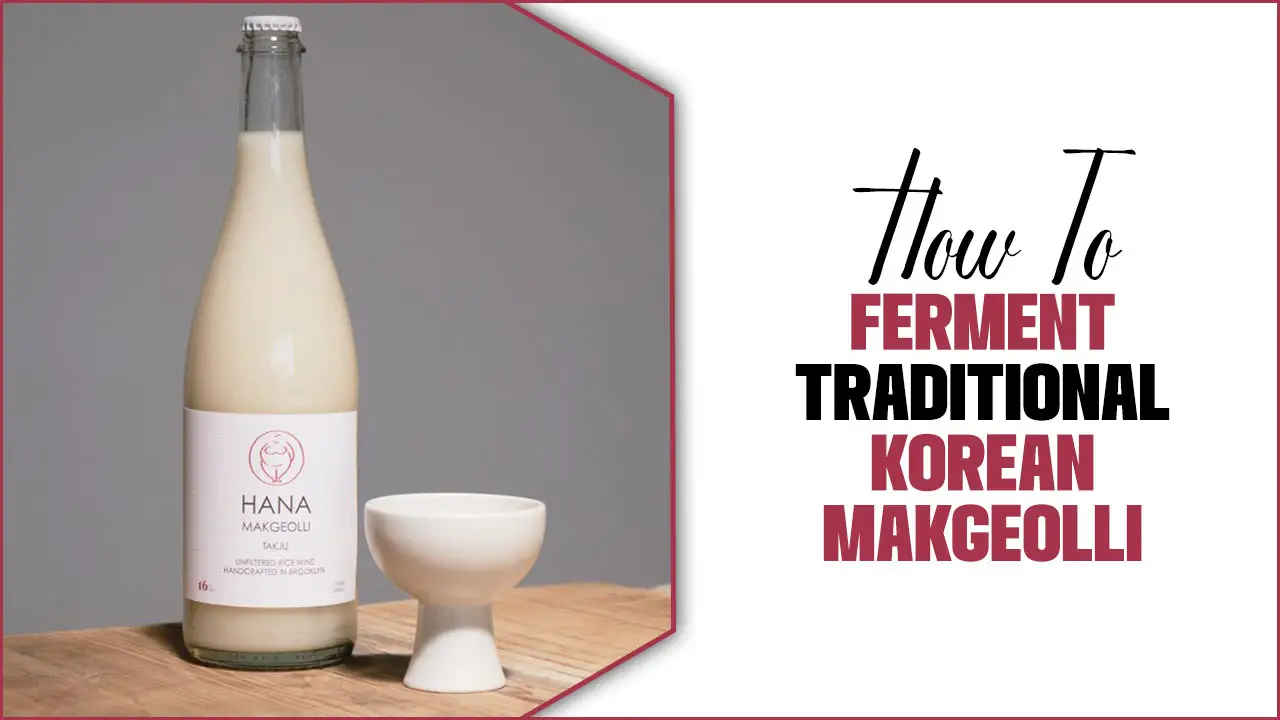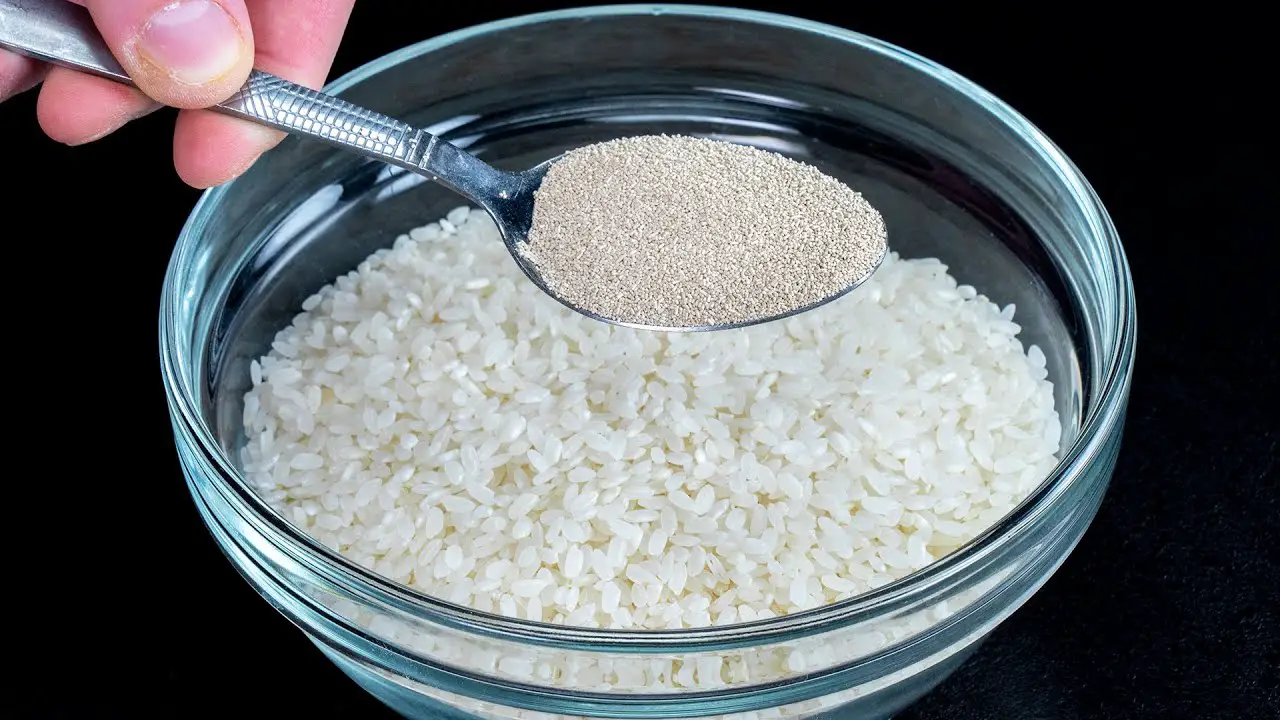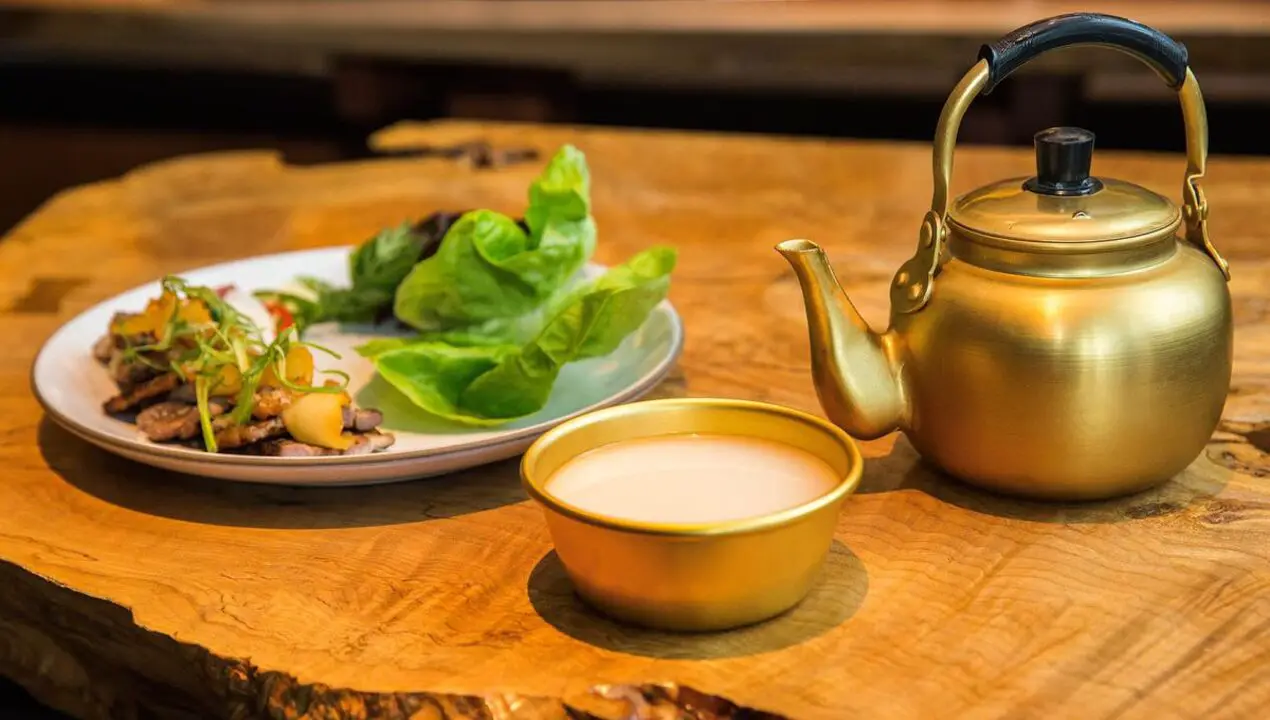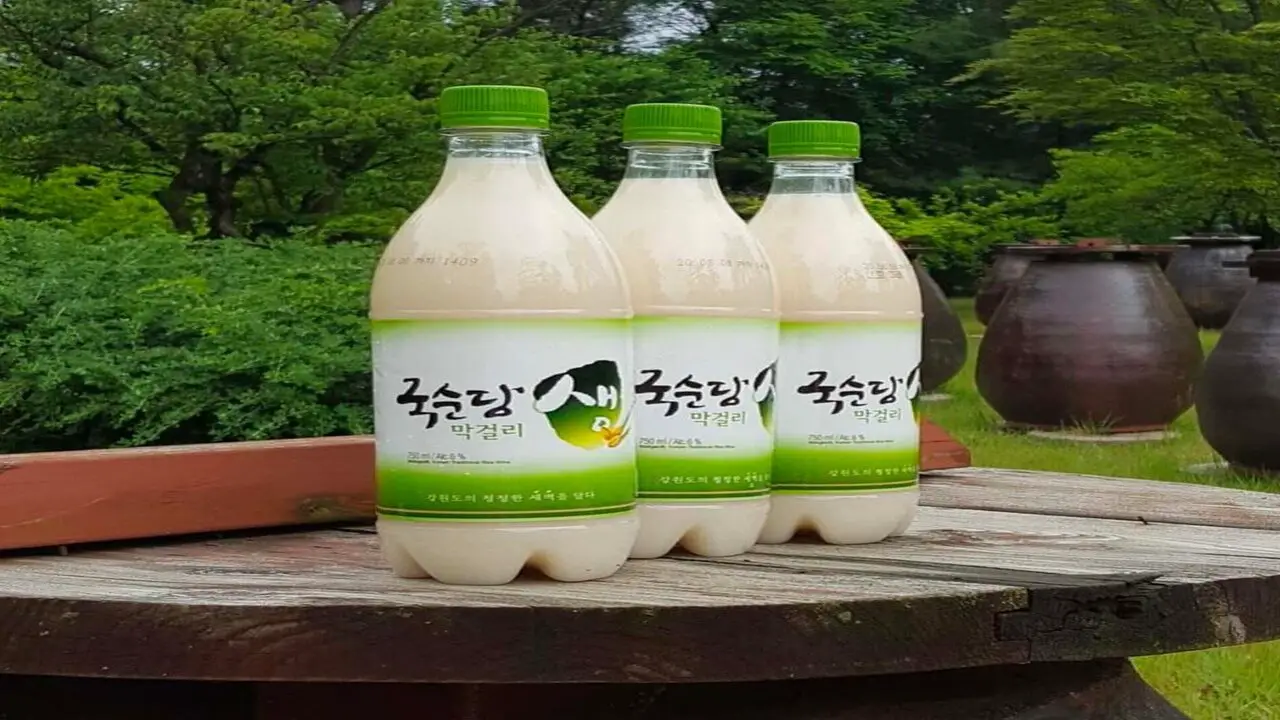A beloved beverage in Korea, makgeolli is a traditional rice wine that undergoes fermentation. Made with rice, water, and nuruk, a fermentation starter, this alcoholic beverage is created over a period of one to two weeks.
Nuruk is vital in breaking down rice starches into sugars, which yeast converts to alcohol. It’s interesting to note that the traditional brewing process involves using clay pots or jars. After fermentation, the makgeolli is strained, bottled, and ready for enjoyment.
Get ready to embark on a delicious journey into the world of traditional Korean Makgeolli. Here we will explore step-by-step instructions on how to ferment traditional Korean makgeolli.
We will even troubleshoot common issues that may arise during the fermentation process and provide tips for making the perfect batch of Makgeolli. So, grab your apron and impress your friends with your homemade Korean alcohol expertise!

How To Ferment Traditional Korean Makgeolli Step-By-Step Instructions

Makgeolli, a beloved traditional Korean rice wine, undergoes a unique fermentation process that creates its distinctive flavor. Crafted using rice, water, and nuruk, this alcoholic beverage ferments for 7-10 days.
With proper temperature control and sanitation, the fermentation process yields a slightly sweet and tangy brew. Renowned for its cloudy appearance and cultural significance, Makgeolli is a must-try beverage in Korea. Here is the step-by-step process on how to ferment traditional Korean makgeolli.
1. Gather The Necessary Ingredients
Gathering the essential ingredients for fermenting traditional Korean Makgeolli is crucial in making this popular rice wine beverage. To begin, wash and soak the rice for several hours or overnight. After the rice has softened, cook it until it becomes sticky.
Once the rice has cooled to room temperature, combine it with water and nuruk—an essential fermentation starter—in a large container. The ratio of ingredients may vary according to personal taste and desired recipe. Cover the rice evenly with the nuruk mixture before moving on to the next steps.
2. Prepare The Rice And Yeast

First, rinse the rice to remove impurities to prepare the rice and yeast for fermenting traditional Korean makgeolli. Then, cook the rice with slightly less water for a firmer texture. After the rice cools, transfer it to a large container. Dissolve the yeast in warm water and add it to the rice, ensuring even distribution. Let the mixture sit at room temperature for 24-48 hours to ferment.
3. Mix The Ingredients
To create the perfect blend of traditional Korean Makgeolli, follow these steps. Start by cooking the rice and letting it cool. Then, transfer it to a large container. In a separate bowl, dissolve the nuruk in warm water until it completely dissolves.
Pour this nuruk mixture over the cooked rice and mix everything thoroughly. Cover the container with a clean cloth or lid, and let it ferment in a cool and dark place for about a week. Don’t forget to stir the mixture once or twice daily for even fermentation.
4. Ferment The Makgeolli
To create the distinctive flavor of traditional Korean Makgeolli, start by transferring the cooked rice to a container. In a separate bowl, dissolve the fermentation starter called nuruk in warm water and pour it over the rice. Let the mixture ferment for about a week in a cool, dark place, stirring it regularly. After fermentation, strain the liquid to remove sediment and transfer it to bottles. Store it in the fridge for a slightly sweeter brew.
5.Filter The Makgeolli

Use a clean, sterilized cheesecloth or fine mesh strainer to strain and clarify the Makgeolli. Slowly pour the Makgeolli through the strainer, allowing the liquid to pass through while capturing any sediment.
Feel free to repeat the process if required for a pristine and velvety result. Once it’s filtered, transfer the Makgeolli into impeccably clean and sterilized bottles or jars, storing them in the refrigerator until they are ready to be enjoyed.
6. Bottle And Store The Makgeolli
When it’s time to bottle and store traditional Korean makgeolli, follow these crucial steps. After fermentation, transfer the fermented liquid to clean, sterilized glass bottles with airtight lids. Leave headspace for further fermentation. Store the bottles in a cool, dark place for 1-2 weeks. This allows the makgeolli to develop its flavors. Practice patience for the best results.
7. Serve The Makgeolli

After fermenting for 7-10 days, the Makgeolli is ready to be served. Gently stir the fermented mixture to mix any settled sediment. Pour the Makgeolli into serving bowls, avoiding agitating the sediment. Serve the chilled or at room temperature, depending on preference.
8. Enjoy The Makgeolli
When indulging in the essence of traditional Korean fermentation, the art of enjoying Makgeolli reigns supreme. With its distinct layers of flavor, this beloved rice wine captures the true essence of the rich Korean culture. To truly bask in the wonders of Makgeolli, follow these steps to savor the fermented beverage.
Initially, gently mix the fermented concoction into a harmonious dance of aromas and tastes. Next, decant it into beautiful, shallow bowls or dainty cups, carefully avoiding dislodged sediment. Finally, enjoy this enticing creation either exquisitely chilled or at room temperature, embracing the flavors of Korea at your own pace.
Troubleshooting Common Issues
To ensure a successful fermentation process for Traditional Korean Makgeolli, it’s essential to troubleshoot common issues that may arise. A cloudy appearance, which is normal, indicates fermentation is occurring. Be aware of any off-putting smells, as they may indicate contamination.
Mold growth is possible if the fermentation vessel isn’t properly sealed or if contaminants are present. Slow fermentation can result from inappropriate temperatures, so check and adjust accordingly. Additionally, a clear liquid separating from the solids can occur due to over-fermentation or improper storage. Simply give the bottle a gentle stir before consuming.
Tips For Making The Perfect Makgeolli

To create a truly authentic and delicious traditional Korean makgeolli, it is important to use high-quality ingredients.
- Start by selecting the best rice available and thoroughly rinsing it to remove any impurities. Soak the rice in water for several hours or overnight to soften it.
- Next, cook the soaked rice until it is soft but still slightly firm. This will ensure that the grains retain some texture after fermentation. Allow the cooked rice to cool completely before moving on to the next step.
- Once the rice has cooled, add nuruk to the mixture. Nuruk is a traditional Korean fermentation starter that contains enzymes necessary for the fermentation process. It can be obtained from specialty stores or online.
- Transfer the rice and nuruk mixture to a large container, ensuring enough room for expansion during fermentation. Cover the container securely to prevent any contamination and allow it to ferment for 7-10 days at a temperature of 20-25 degrees Celsius.
- Natural fermentation will occur during this time, transforming the mixture into makgeolli. The longer you let it ferment, the stronger and more complex the flavors will become. After the desired fermentation period, strain out any solids and transfer the liquid into bottles for storage.
Now you have created your own homemade traditional Korean makgeolli! Enjoy its unique taste and smooth texture, and feel proud of your brewing skills. Cheers!
Conclusion
Making your own traditional Korean Makgeolli can be a fun and rewarding experience. By following the step-by-step instructions on how to ferment traditional Korean makgeolli, you’ll be able to create a delicious batch of Makgeolli right in your own home.
Remember to gather all the necessary ingredients, prepare the rice and yeast properly, and follow each fermentation and filtering step carefully. With a little patience and practice, you’ll be able to enjoy your homemade Makgeolli in no time.
For troubleshooting tips and additional guidance on making the perfect batch of Makgeolli, check out our blog. And if you’re wondering what kind of rice is used in Korean traditional alcohol, we’ve got you covered too. Start fermenting your own Makgeolli today and experience the authentic flavors of Korea.
Frequently Asked Questions
1.What Yeast Is Best For Makgeolli?
Ans: For making traditional makgeolli, nuruk, a Korean fermentation starter, is preferred over yeast. Nuruk contains a mix of microorganisms that contribute to fermentation, resulting in an authentic flavor.
2.Can You Make Makgeolli Without Nuruk?
Ans: No, nuruk is a crucial ingredient for authentic Korean makgeolli. It contains enzymes that break down rice starches into sugars fermented by yeast.
3.What Kind Of Rice Is In Korean Traditional Alcohol?
Ans: The rice used in Korean traditional alcohol, Makgeolli, is typically short-grain rice. Specifically, a type of rice called “nuruk” is commonly used. Nuruk acts as a fermented starter and contains enzymes that break down the starches in the rice.
4.What Is Makgeolli, And Why Is It Good For You?
Ans: Makgeolli is a traditional Korean rice wine that undergoes fermentation with rice, water, and nuruk. It has a milky appearance and a sweet, slightly tangy taste.
5.Does Makgeolli Really Work?
Ans: Makgeolli, a traditional Korean rice wine, has probiotic benefits due to its fermentation process that produces lactic acid. It may improve digestion and boost the immune system, according to some studies.

I’m a writer and blogger who loves to talk about entertainment, culture, and relationships. I love to share my thoughts and insights on these topics, and I’m always looking for new ways to engage with my readers. I’m also a big fan of learning new things, so I’m always exploring new areas of interest.
